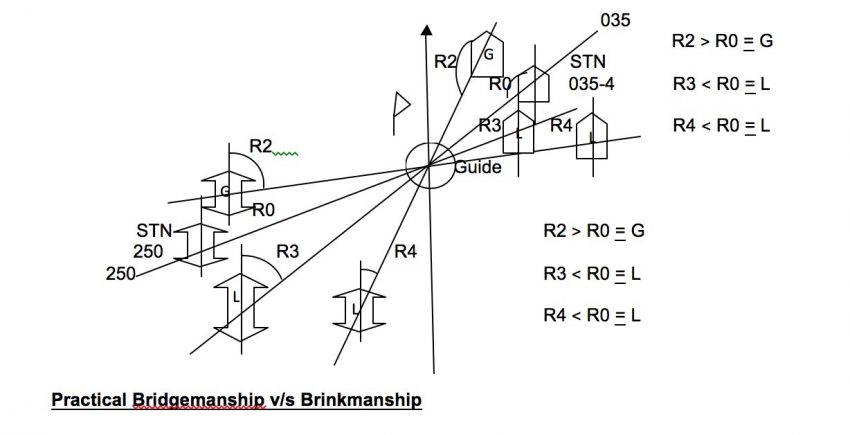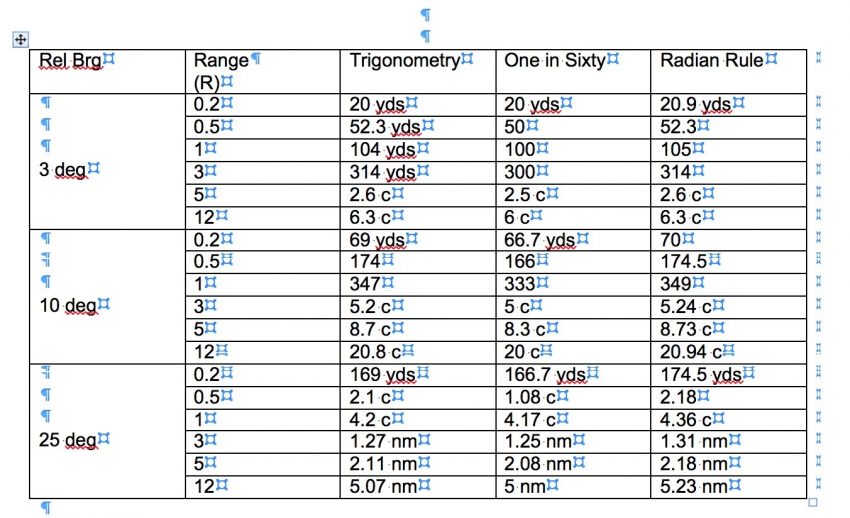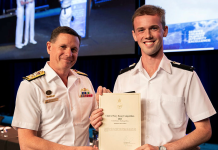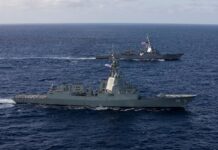By Commander Sudarshan Shrikhande, IN*
Author’sNote: This memo was written by the author in October 1998 while at sea in the Malacca Strait as a commander when he was Executive Officer of the Indian Navy’s then newest destroyer, INS Delhi. For all navies and indeed all mariners, the issue of collisions at sea always remains, quite unfortunately, a topical one . The recent collisions suffered by the USN have elicited many thoughtful, and some rather bizarre commentaries. Readers of this Memo, whether seamen with crows’ feet around their eyes or young bridge watchkeepers and personnel, may find some reiteration of basics. This is never a bad thing. Along with the adage that if something is too good to be true, it probably is, one can add that if your eyes tell you something is not quite right, it probably isn’t. The Memo was published in “Dhruv”, the IN’s journal periodically published by the Navigation & Direction School in 2011. It is slightly abridged and edited here.
This was written some years before AIS and further cluttering of bridge and ops room displays with labels and other contact info about merchantmen that makes it more difficult to assess how rapidly that label in the guise of a 200 m trader can close a warship or we close it
1. As the XO, I am for the first time at sea in a job that does not require prolonged presence in the bridge. The Captain spends long hours in the bridge and all you have watches to keep anyway. I do more unglamorous things like look after housekeeping, run the ship and be responsible for her fighting efficiency! However, based on what I have observed from and on the bridge, on my own experience as a watchkeeper (watches always give me a “high”) and on observations made by the Old Man to many of you, some tips and suggestions are made below. What I am trying to put across is neither a critique, nor a comprehensive guideline. It may justifiably seem “old hat” to many watchkeepers. It is old hat but may do with some repetition.
2. How Come The Old Man is the Sharpest Watchkeeper? Is there anyone who has not experienced the truth of the question many times over in many ships and with many captains? I think I understood the reason during the time I sat in the skipper’s chair of a small ship. OOWs (Officers of the Watch) sometimes get bogged down with the nitty- gritty of the watch, spending more time peering through gyro repeaters, station keeping as THE major activity and sometimes worrying about what the Captain might say about their watchkeeping rather than merely keeping a good watch. I think it essentially requires an ability to avoid focussing only on one issue and constantly scanning the horizon, keeping eyes and ears open, evaluating technical inputs (radar, echo sounder, gyro, log… etc). That is what the Old Men do and it is no big deal that they are sharper. They crows’ feet around the eyes do have some significance! However, age does not have to be on the higher side to be a good watchkeeper.
“Watchkeeping” is the Key
3. Binoculars. The primary task of an OOW (includes Asst OOW, Midshipman of the Watch) is to WATCH. This is not necessarily a strong point of some watchkeepers on board, but invariably ought to be. Among the many instruments that help us, binoculars are perhaps most indispensable. A few are available on the bridge and must be always around the neck. Also see pages 8-9 of ‘Naval Ship Handling’ – by Crenshaw to read about how binocs (7×50) are useful for estimating range. Apply this to station keeping.
4. Conn Tact! If a “Down with the Pelorus Party” is formed, I would be a very vocal supporter. The pelorus is merely a centre – line repeater and enables you to take a bearing. It is not the Conn. In fact on more than one occasion, I have heard experienced OOWs sternly advise the AOOW/MOW not to move from the Conn. As I understand, the conning position may be a tangible area which may consist of the entire enclosed bridge or the wings or bridge top, depending on the circumstances. Conn, on the other hand is definitely a Command and control function as in “you have/I have the Conn….” It is not tangible. If the temptation to hold on to the Pelorus ring is overcome, the whole bridge will suddenly become yours to activate. That is your part of ship. Let me assure you that many ships do not have a Pelorus. It makes life difficult for taking bearings if it rains, but otherwise those ships have smart watchkeepers too. Please don’t let the pelorus fascinate you so much!
5. Walking About. Once an OOW weighs anchor from the pelorus (or its close rival, the CTD!) a whole wide, new world is yours to behold. Walk from wing to wing; play with the CTD (but don’t give yourself a crick in the necks by failing to watch outward; watch the fellow astern; see what you can see of men on deck…….. As you read this many may have an indignant thought: “what’s new? I do this anyway!” You may be right — but the Captain has seen some drawbacks and so have I.
Common Sense Must be a Common Virtue
6. Lessons in Drawing. Drawing left/ drawing right does not seem as confusing, mercifully, as some of the MF Hussain’s art. (Note: Hussain was a famous Indian abstract artist). To restate the obvious, I have composed some doggerel below.
If on STBD and drawing RIGHT,
You might consider sitting TIGHT;
If on STBD and drawing LEFT,
On your oars, do not rest.
If on PORT and drawing LEFT,
You could put your mind to rest;
If on PORT and drawing Right,
Inaction results in interesting plight.
In any case, you’ll do well to monitor,
Rate of change,
And how much water,
There is between you and a minor disaster.
7. Progressing “Drawing” Lessons. One of the more common pitfalls in the determination of drawing left/right situations is that OOWs do not take a bearing at the first instance and / or keep it in their memory for comparison. However, a mental bearing record (which should be reasonably accurate) is not only useful, it is necessary. A serious case is one in which the OOW has not kept such a track, but nonetheless provides a readymade answer to the Captain. This is unprofessional. Determine if the contact is actually drawing left/right qualifying it with “Slowly/ rapidly” or on a steady bearing. A very good system, which an Old Man follows is to see how the object moves relative to. a particular bridge window, wiper blade, deck fitting etc. This he does sitting in his chair and the green Sub/Mid OOW wonders “how come”? You too can do this by occasionally comparing your photographic memory with the current situation from a particular position on the bridge (may be even the Pelorus!)
8. Gaining/ Losing Bearing. It is not surprising that some OOWs do complicate the gaining/losing bearing issue for themselves. Whether this is in station keeping or in an ROR situation, we should not get bogged down by the actual bearings or a ‘BRG should be abc, but bearing is xyz comparison. Rather, the two simple rules that may be considered are as follows:
(b) If relative bearing is now greater, you have gained bearing, If Rel Brg is lesser, you have lost brg. This is shown in a simple diagram.
9. Seaman’s Eye. By aspect of a target (a generic term) we do, usually, determine what the further action(s), if any should be. On the whole, a radar helps us fine tune the situation and update/revise the picture formed by the mind’s eye. At the same time it is certainly not advisable to keep looking implicitly at the CTD. In the next few paragraphs a few rules of thumb, if you like, are explained briefly, the ideas explained are as follows:
(a) Angle on Target’s Bow (ATB)
(b) Quick estimation of worst case CPA.
(c) Speed/time/Distance Calculations.
10. ATB. Angle on Target’s Bow is related to “Inclination” as given in fig 1-15 of the old Seamanship Vol I. In simple terms, and literally meant by ATB, it is OUR relative bearing for an observer on the TARGET. The term started from the earliest days of Submarine Warfare wherein the S/M had to favourably position herself on a target’s bow at the time of firing torpedoes. But the issue of LLA’s (Limiting Lines of Approach) and ATB remain valid even today. The “B” of ATB can be considered from RIGHT AHEAD to R/G 180. On the reproduced Seamanship Vol figure, the ATB is simply 180 deg minus INCLINATION. In a subsequent addendum to this note, we shall see how a ATB helps us all on the Bridge in some REL VEL problems and is not some vague term used by the ASWO or by a veteran Submariner! (The then CO of INS Delhi was a submariner and I an ASW specialist).
11. CPA and the Radian Rule. Very often, young officers rattle out the radian rule, but find it difficult to apply it to situations as they occur. In most cases, we need to determine the outcome in a general sense. Once you see a fisherman or a buoy or a danger mark or a merchantman on a similar or nearly reciprocal (±15 deg will do) course, assume that the target is stationary (i.e. it has a reciprocal course automatically). Calculate the lateral separation with his relative bearing and range as inputs. This can be done by three methods but the One-in-Sixty Rule is the simplest and sufficiently accurate. The lateral distance you get should be analysed as a ball – park figure with the following factors in mind:
(a) Based on the target’s aspect (ATB) is the CPA likely to be lesser than your figure? If the answer is an obvious yes, you could contemplate further actions and / or monitoring.
(b) If the CPA is likely to be greater, then monitoring may be continued, but you may bestow less attention on the target depending on the circumstances.
(c) If the target is stationary, the CPA is at lateral range.
12. Calculating CPA. As you are aware, circumference of a circle is 2πr or 2π radians. This means that the arc subtended by an angle of 360 deg is also the circumference. Therefore one radian = 360/2π = 57. 295 = 57.3 degrees. Now look at
(d) The actual CPA is a perpendicular distance and a straight line. Can be calculated only with trigonometry.
(e) The real radian rule (i.e. 57.3) accurately gives only the arc and the lateral range is lesser. This is not very useful because it errs on the wrong side of safety.
(f) Our radian (i.e. one is sixty) rule is quick and sufficiently accurate since the denominator 60 reduces the arc from given by denominator 57.3 and provides a greater margin of safety.
(a) While Trigonometry is most accurate, one in sixty is sufficiently accurate. In any case, as the angle and range increases, it UNDER READS CPA. Therefore, any actions to increase CPA, increase the margin of safety. E.g. a 10 deg Rel Brg at 5 nm gives us 8.3 c whereas actual is 8.7 c. This is about 80 yds on the side of safety which is 4 times our beam and nearly half our length.
(b) Radian rule gives a larger CPA, is difficult to calculate and at larger angles is much more inaccurate.
(c) So, the One- in- Sixty rule works just fine!
14. Putting It to Work. Probably this requires no explaining. Young watchkeepers should simply try and practice the Radian rule (sixty) and play with the results by changing the Rel Brg to increase/decrease CPA etc.
15. Speed/Time/Distance. A useful rule- of-thumb is to have the six minute rule and the three minutes rule to cough up answers quickly.
(a) Six Minute Rule
(i) In 6 Minutes 15 kts = 1.5 miles
24 kts = 2.4 miles etc.
(ii) At 22 kts 6 min = 2.2 nm or 4400 yds
3 min = 11 cables or 22×100 = 2200 yds
1 min = 3.6 cables
(b) Three Minute Rule. Speed in kts is as many hundred yards convert in 3 minutes. Or 21 kts is 2100 yds in 3 min. etc. This gives its own sub rules
(i) 1 kt = 100 yds in 3 min
(ii) 1 kt = 33 yds per minute
(iii) 1 kt = 0.5 yds (or 1.5 ft) per second.
16. Occasions. Almost every situation of station keeping, RAS, manoeuvreing requires us to do speed/time/distance calculations. Keeping in mind own acceleration/deceleration (i.e. yards/kt) we can order speed changes with reasonable precision. After all, changing/maintaining station generally means having a speed advantage (4, 6, 7, 10 kts etc) over the Guide. Therefore time taken to cover distances at relative speeds is calculable. As offshoots are issues of when to increase/decrease speed, alter in / out etc. Everything can be quickly and easily calculated.
Negotiating Merchantmen and Fishermen
17. Sea Manners and Discipline of Merchantmen. In all the years spent by us at sea, we may have come across only a handful (may even be lesser) of merchant ships who have acted stupidly or embarrassed us. It may be better to remember that they have been at it for many years, are keen to keep their track and ETA; are not very manoeuvreable; do not have an OTC or a bridgeful of people; have met many naval formations at sea; do not have Officers and crew who get paid the same if sitting in a shore job! On the other hand, perhaps warships break ROR discipline more often than acknowledged.
18. Crowded ISLs. We have comfortably passed scores of ships at 3c – 5c in the Malacca Strait and we could have walked the plank to some ships in the Song Saigon! Life seemed comfortable, didn’t it, once you knew each other’s PIM? Sometimes, and this is not a cynical view, we tend to make a fuss over many things because at times there are more officers than work on the bridge. While in a formation we generally see that ships pass 2 nm or 3 nm clear. However, in many cases it should be a safe distance according to the prevailing circumstances, standing orders etc. It many cases, even 2 – 3 cables can be safe provided PIM is mutually clear. In general, it is easy to monitor merchant ship tracks (along ISLs). Since they sail at service speed (max or nearly max) they do not generally like to slow down and cannot go much faster. However, if overtaking, they are not likely to give a very wide berth. If possible, give him more sea room and watch his movements. Remembers he does not have a bridge full of personnel, only a loudspeaker watch on Ch 16, relies on ARPA and does not get excited easily. As a general guideline, observe without any alterations of own course till the ship comes to 3-5 nm. Have your options (governed by ROR, good seamanship, FXP(Fleet Exercise Programme), formation, etc) figured out. If the Captain is not on the bridge, make a good sitrep to him on current PIM, CPA and CPA after your proposed alteration. Chances are he will say OK and catch up on sleep! In general, do not raise hell on Ch 16 with the merchantman if he has not violated anything.
19. Fishermen. As every single Sub and Mid has seen, there usually are convenient gaps between a whole “city” of lights ahead of you although this may not initially seem so. Very often, fishing boats in a given area are moving in a general direction that helps their catch; they are not unconcerned about their nets or their lives. However, they do not clear away except just in time. Therefore, as you may have been advised umpteen times by the Captain, it is just better to clear away in the direction most logical. Monitor bearing change, watch carefully through binocs, determine side of nets and other boats you may encounter subsequently. Reduce speed to get better manoeuvreability. If required at closer quarters, sound a prolonged blast or 5+ short blasts etc. If a close quarters situation develops, immediately on clearing him, swing the stern away. It may save our props and his livelihood. Avoiding fishing is somewhat like Chinese checkers.
Summing Up
20. This note, as you may grunt to yourself, says nothing new. You are right. It is merely to draw your attention to the obvious once again so that watchkeeping quality, efficiency increase even as decibels reduce!
21. I have always found watches exciting and took quiet pride in trying to be a good watchkeeper. Even as a Sub, take enough initiative to make the OOW a superfluous safety officer. It is not difficult and has been done by hundreds for perhaps as many years! When you do this, you will find even while taking up station, there is no need for anyone to sing out “continuous” ranges on bearings or “continuous” anything. If you have worked out a manoeuvre in your mind, and are evaluating all inputs (NOT by hanging on to the Pelorus) the errors are likely to be small and easily correctable and without 3-4 assistants rattling out ranges, bearings etc “continuously”. And so what if a manoeuvre in somewhat screwed up? Chances are you will realise the error well not repeat it.
Note:








